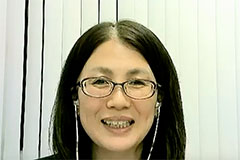Japanese Brazilians in Japan and Japanese Society from the Perspective of Education—Seminar Series on Migration History and Multicultural Understanding in Japan
2022.04.12
The open seminar series on “Migration History and Multicultural Understanding in Japan: Understanding ‘Others’ from Historical Perspectives,” co-hosted by the JICA Ogata Sadako Research Institute for Peace and Development (JICA Ogata Research Institute) and the Japanese Overseas Migration Museum at JICA Yokohama Center, started. Of a series of six seminars, the first one was held on Jan. 18, 2022, and Haino Sumiko, associate professor, Kanda University of International Studies, gave a lecture on how South American Nikkei people (i.e., descendants of those who emigrated from Japan to South America) came to Japan and permanently reside here, focusing on the Japanese Brazilian communities and their education in Japan.

Nagamura Yukako, research fellow at JICA Ogata Research Institute
Following opening remarks by Nagamura Yukako, research fellow at JICA Ogata Research Institute and chief of the institute’s project “Study about Movements and Networks of Japanese Descendants between Japan and Latin America,” Haino’s talk started with the question, “Who are the Nikkei?” She looked back on the history of the Japanese emigration to South America that started at the end of the 19th century and gave an overview of life at the time in Japanese immigrant communities and their current situations. As many Japanese immigrants to Brazil migrated alongside family members back then, Brazil has the world’s largest Nikkei population of 1.9 million. Although fewer Nikkei people understand Japanese after several generations, Haino said that many of them still feel a close connection with Japan as they have been called “japonês (Portuguese for ‘Japanese’)” by the locals. In addition, she explained that the implementation of the 1990 amendment of the Immigration Control and Refugee Recognition Act of Japan, which enabled second and third generation descendants and their family members to legally work in Japan, along with an underlying South American economic stagnation and the Japanese labor force shortage caused by the asset price bubble at the time, led to a sharp rise in the number of Nikkei people and their family members from South America entering and staying in Japan. As of the end of 2020, around 200 thousand Japanese Brazilians and their families lived in Japan. Haino pointed out that repeated back-and-forth traveling between Japan and Brazil, depending on the economic situation of the two countries, is a key feature of the migration of Brazilians living in Japan, caused by its legality.

Haino Sumiko, associate professor, Kanda University of International Studies
Based on previous studies, Haino explained how the collective identity shared by these Japanese Brazilians has changed over the years. Many of them originally intended to migrate to Japan for employment and money, planning to return to Brazil after a few years. In the 1990s, a new Portuguese word “decassêgui (coming from the Japanese term ‘dekasegi’ which means ‘short-term migration for employment’)” was born. In the 2000s, their collective identity changed from “decassêgui” to permanent residents (immigrants) and in the 2010s, it further changed to members of overseas Brazilian citizens communities scattered around the world. In 2015, the Yokohama Declaration, stating that the era of “decassêgui” has ended and the Japanese Brazilians have chosen to remain in Japan, was made, and Haino said that this marked how the Japanese Brazilians residing in Japan themselves ushered in a new era. Following these changes, they have been confronted with various challenges. One particularly serious challenge is the education of second generation children growing up in Japan. As of the end of 2020, there were about 30 thousand Japanese Brazilian school-age children (ages 7 to 18) living in Japan. Although they have the option of attending Japanese public schools, private Brazilian schools or both, continuity of education cannot be maintained in the case of children whose place of residence depends on their parents’ circumstances, making them unable to picture their future. As a result, in reality, some school-age children are not registered for and/or are not attending any school.
How can we solve the issue of Japanese-Brazilian children in Japan being unable to have a sense of belonging or self-esteem? One hope Haino introduced was PLH education. PLH (an acronym of the Portuguese term “Português como Língua de Herança”) refers to “Portuguese as a Heritage Language” passed on to next generations after immigrating to a country where a non-Portuguese language is mainly in use. PLH education aims to enable these children to communicate with their parents and not struggle with language barriers when they return to Brazil. It also creates opportunities for them to communicate with Japanese people and be able to live in Japan without difficulties. Haino said that PLH education and learning about immigration context can allow Japanese-Brazilian children in Japan to find a positive way forward in being Japanese Brazilians and be assured of a sense of belonging, both to Japan and Brazil. Furthermore, following such movements, she said that Japanese society has started to change; for instance, by encouraging children of non-Japanese citizenships to register for school; or by trying to make classes easier to understand for those not fluent in Japanese. She talked about her ambition, that she would like to continue to look for answers to many questions: Who sacrificed themselves to promote such changes? Why is the situation where Japanese-Brazilian children in Japan are unable to have a sense of belonging to anywhere persistent after nearly three decades? How have Japanese young people who grew up with children with connections to Brazil been influenced?
In the Q&A session, a Japanese-Brazilian student asked what issues Japanese Brazilians residing in Japan are being confronted with and what challenges in education exist. A Japanese participant who runs a Brazilian school commented that he is constantly asking himself how to respect the identity of children who were born in Japan and are growing up in Japanese-Brazilian communities while building them connections with Japanese society. The seminar left a strong impression that Japanese emigration history and multicultural awareness are not confined to the context of academic studies but rather rooted in people’s daily lives.

事業事前評価表(地球規模課題対応国際科学技術協力(SATREPS)).国際協力機構 地球環境部 . 防災第一チーム. 1.案件名.国 名: フィリピン共和国.

事業事前評価表(地球規模課題対応国際科学技術協力(SATREPS)).国際協力機構 地球環境部 . 防災第一チーム. 1.案件名.国 名: フィリピン共和国.

事業事前評価表(地球規模課題対応国際科学技術協力(SATREPS)).国際協力機構 地球環境部 . 防災第一チーム. 1.案件名.国 名: フィリピン共和国.

事業事前評価表(地球規模課題対応国際科学技術協力(SATREPS)).国際協力機構 地球環境部 . 防災第一チーム. 1.案件名.国 名: フィリピン共和国.

事業事前評価表(地球規模課題対応国際科学技術協力(SATREPS)).国際協力機構 地球環境部 . 防災第一チーム. 1.案件名.国 名: フィリピン共和国.
scroll